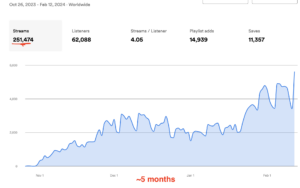Looking for the best email marketing tool for your music?
Here’s our list of the top 5 in 2022:
Looking for the details on each? Keep reading.
Email marketing is still super relevant (for musicians, too).
17% of adults in the US check their email as soon as they wake up, and some research showed that the average working person checks new messages 77 times a day. These mindblowing statistics should give you an idea of how crucial it is to develop a consistent email marketing campaign for your music project.
Luckily, there are plenty of tools that can help you improve your workflow and reach a wider audience. Let’s find out more about the best email marketing services for musicians!
First of all, why do musicians need email marketing?
Simply put, it’s your only way to directly connect with your fans without the support of social media platforms that might hide your content from a new audience. In a way, you own your contact list!
But remember, the attention time spent reading emails is between 10-15 seconds. Keeping it simple and eye-catching is crucial, as well as having complete control over the content and its quality by creating campaigns yourself. It’s not much effort and time, and the return on investment can be huge.
1. ConvertKit
ConvertKit is probably one of the best email marketing tools available, as it is designed with online creators, influencers, and marketers in mind to grow their digital businesses. It also offers customizable sign-up forms and landing pages to help attract more email subscribers. In addition, you can build and manage your lead databases, create and send email messages and campaigns, and automate message sequences.
ConvertKit is the perfect tool to get you started with your email marketing campaigns to capture leads for your music enterprise. An intuitive and easy-to-use tool that offers numerous features:
Don’t worry about forms anymore! With ConvertKit, it’s super easy to create and edit forms with different templates or pre-defined formats. With a few clicks, you can publish a responsive and professionally designed form on your website and start collecting emails.
Landing pages are an excellent tool for growing your email lists. It’s where you “land” on after clicking on the link you provided, for example, in an email. If you want to generate more traffic within your fans’ community, with ConvertKit, you can create unique landing pages.
Use this tool for advertising your new hit or album. One of the best features is that you can test different titles or subjects using the automatic A/B test function. In addition, you can visualize the design of each email.
Automation is one of the best tools offered by ConvertKit.
For example, if you have a new subscriber, you can do a welcoming or “onboarding” process so that they learn how to use your product or how to navigate through a new platform. Automation is the key to scheduling emails and maximizing the impact of your campaigns.
WordPress, Shopify, WooCommerce, Zapier, and Stripe are just some of the platforms ConvertKit is integrated with. This makes it super easy to connect this email marketing tool with other apps you use to manage your music career.
The reporting area in ConvertKit offers the possibility to analyze your main metrics to measure how effectively you generate new subscribers, as well as the degree of performance with which your email marketing campaigns are working. This helps you make better decisions and constantly improve your strategy.
Filters allow you to display only specific information according to what you want to analyze at a specific time. Filters can be applied to all necessary functions (tags, products, subscribers, emails, and others).
Perhaps the most important aspect of ConvertKit is the fact that it allows you to analyze the results of your campaigns thoroughly.
Pricing
ConvertKit offers plans that are priced according to the size of the subscribers. For example, users with a list of up to 1,000 subscribers can use their free Plan, but if you need advanced tools, they’re only available on the paid plans.
The free Plan includes up to 1000 subscribers. With unlimited landing pages and forms, email broadcasts, Sell digital products and subscriptions, and Email support.
Creator Plan starts from $29 per month (Up to 1,000 Contacts), the same as the free Plan, plus free migration from another tool, automated email sequences, automated visual builder, etc.
Creator Pro Plan starts from $59 per month (Up to 1,000 Contacts), which also gives you subscriber scoring, a newsletter referral system, and advanced reporting.
For more information, check their pricing page.
Pros
- Easy to use, very intuitive, and user-friendly.
- Filter subscriber lists, making a single list without duplicates.
- Integrations with other useful platforms, such as Elementor PRO.
Cons
- Forms are basic. ConvertKit believes in simple email designs that don’t use images or graphics. If you’re someone who believes the best way to engage a fan is visual, this option may not be the best for you.
- Limited automation: although ConvertKit allows you to create automation, it’s still basic compared to the advanced automation offered by the competition.
- Limited A/B testing: You can’t do advanced split testing in ConvertKit, which is limited to email subjects and a few other elements.
Want to give ConvertKit a spin? You can check it out here.
2. Mailchimp
Mailchimp is one of the most popular tools for email marketing online. Even so, many people don’t know what it can do aside from sending messages. In fact, Mailchimp brings together a number of solutions that make it easier to plan, carry out, and keep track of marketing plans as a whole.
You can divide your campaigns into groups, choose which statistics you want to track, run A/B tests, connect the service to other tools and/or platforms, and use the available templates to enhance your audience.
Pricing
Mailchimp offers many pricing options for Marketing, Websites and Commerce, and Transactional Email.
Marketing plans:
Like ConvertKit, pricing increases depending on the number of subscribers. As you acquire more, your plan options will become more limited. For example, if you have more than 2,500, you’ll need to use the premium plan.
Websites & Commerce plans:
All of their three plans (even the free one) include transaction fees and Stripe processing fees. The Core plan is for $10/month, and a Plus plan is for $29/month.
The transactional email plan:
Here you have the option to add “blocks” of emails within your existing MailChimp account.
Blocks cost between $10 and $20, with better prices when you buy in bulk.
Pros
- Multiple pricing options
- More than 100 templates
Cons
- Affiliate marketing is not allowed
- Can get very expensive very quickly
- Lack of data about your audience in the Free and Essentials plans
Ready to give Mailchimp a look? Check it out here.
3. Drip
Drip is a cloud-based marketing automation software that gives users the ability to easily automate their email and SMS marketing activities, thereby generating new leads and increasing sales.
Designed for use across multiple channels, Drip also provides users with the added benefit of obtaining information from buyers (or potential buyers) for personalized responses and ads, as Drip incorporates CRM into its automation services.
No prior coding experience is required, as it has a highly-praised and easy-to-use user interface. (This is the platform we use to send emails at Two Story Melody.)
Pricing
The price varies on the number of email contacts you have. You can start with the 14-day free trial:
You have the option of sending unlimited emails to up to 2500 email contacts. After that, you will be charged $39 per month.
Pros
- Easy-to-use user interface
- Customizable workflows
- Easily integrates with tons of e-commerce platforms, shopping sites, marketing applications, social networks, etc.
- Multi-channel marketing automation services (SMS, emails, social media platforms)
- Free migration from one Plan to another
Cons
- Analytics reports lack critical details
- No real-time sales alerts
- No mobile phone application
Want to try Drip? You can check it out here.
4. Substack
Substack allows you to create an email newsletter in less than 5 minutes without coding skills. Plus, you have the option to charge your subscribers for premium content.
In addition, it automatically creates a page where you can have all the previous editions of your newsletter and a system to acquire new users through a very simple registration form, which makes it very easy to subscribe to your newsletter.
It also offers the possibility of creating paid newsletters, so you can monetize your content with a 10% commission on the price you set.
Pricing
It’s free until you start charging your subscribers to get premium content. After that, Substack will take 10% of the fees.
Pros
- Creating newsletters is extremely easy and fast: Substack is a tool designed to write and not worry about anything else.
- Automatic sign-up page.
Cons
- Very limited personalization: All newsletters made with Substack look very similar.
- Can’t personalize automatic emails: for example, the subscription confirmation email.
Ready to write on Substack? Get started here.
5. SendinBlue
The Sendinblue email marketing platform focuses on automating email marketing at a reasonable price. SendinBlue allows you to communicate with your audience effectively thanks to an impressive email automation system, as well as text messages and chat.
With 65 templates to choose from, all fully customizable, SendinBlue offers an intuitive platform ideal for those who don’t have any coding skills. Thanks to a powerful drag-and-drop page editor, the ability to create filters that act as segments based on different criteria, and customizable fields and registration forms, SendinBlue is undoubtedly one of the best options in the market.
Pricing
The Free version allows sending up to 300 contacts per day and unlimited subscribers.
The Lite version costs 25 USD per month. It allows sending unlimited emails per day and up to 20,000 emails per month. If you have more emails, the price will increase.
The Premium version costs 65 USD per month. In addition to the previous packages, it adds marketing automation, Facebook ads, multi-user access, and support. On the other hand, it has a landing page generator (where users arrive after clicking on a specific action), which makes it an excellent service for the price.
Pros
- Free version and unlimited contacts. It allows the registration of up to 300 contacts per day in its free version, allowing unlimited contacts for this version.
- Platform with pre-defined and customizable templates in its paid versions.
- It offers professional email automation.
Cons
- Automation only in the paid versions (Premium version).
- Presentation of the SendinBlue logo in the emails sent to customers in the free version and even in the Lite version. This could make email marketing difficult for those companies that want their logo to appear in these emails.
Final Thoughts on Email Marketing Services for Musicians
Regardless of the email marketing service you opt for, you should ensure the quality of your message can engage your music fans. Some artists opt for a basic email marketing campaign focused on delivering crucial messages at the right time. Others use their email marketing service to constantly connect with their fans and engage in regular conversations.
First of all, define the way you want to communicate with your audience. Next, choose an email marketing service that suits your needs and won’t compromise your budget.
Good luck, and stay creative!









